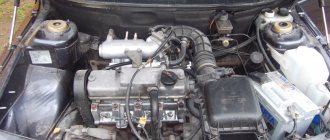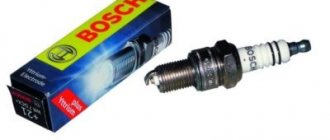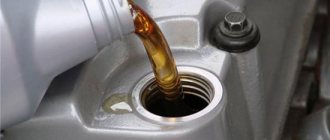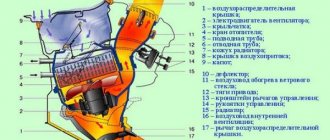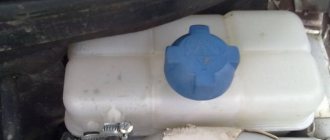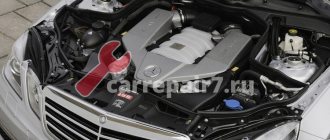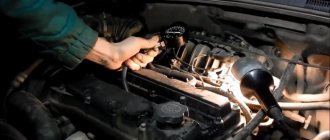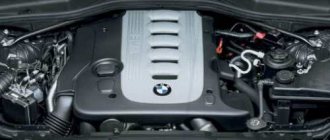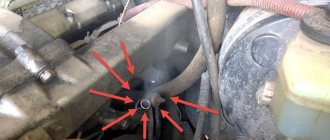The situation when the engine does not heat up to operating temperature is quite common in gasoline and diesel cars. At the same time, many car owners do not pay due attention or do not notice this malfunction at all, especially in the warm season. The reason is simple - drivers are more afraid of overheating, but not everyone knows about the consequences of driving on a cold or insufficiently warmed up engine. So it turns out that if a gasoline or diesel engine does not reach operating temperature, the arrow of the temperature indicator on the dashboard does not reach the desired value on the scale, you can still drive. However, it should be taken into account that engine wear increases, the fuel appetite of the unit increases, the exhaust becomes toxic, the engine “pulls” worse, etc.
We also recommend reading the article about why the engine loses power. From this article you will learn about the main reasons why the engine does not gain speed or does not provide full output.
Typically, problems that cause the engine temperature not to rise become relevant with the onset of cold weather. The main sign of a problem is deterioration in the operation of the stove. In other words, the operating comfort of the vehicle decreases due to the low temperature in the cabin, which forces the driver to take action. Next we will talk about what to do if the engine operating temperature is low, the engine takes a long time to warm up to operating temperature, etc.
Why is it necessary to warm up the engine?
Warming up the engine began in the last century, when the vehicle was moved after the engine had reached the desired temperature. Warming up occurs at idle speed. Before moving, you need to wait a few minutes so that the motor does not stop along the way. All parts warm up and function normally. Warming up is necessary to ensure normal engine operation, narrowing the gaps between parts, maintaining the required viscosity of the engine oil and reducing fuel consumption.
External cleaning
It happens that after cleaning the car, the engine heats up again. In this case, GAZelles and other domestic cars must undergo purging of the radiator walls. The essence of this method is to remove various deposits that have accumulated on the outer part of the element. This could be midges, poplar fluff and other debris that interfered with the normal heat exchange of the radiator with the external environment. You can blow or wash the walls of the part manually, using a vacuum cleaner or hoses. But it is best to clean out the garbage under high pressure. At the same time, remember that the radiator honeycombs are very fragile and thin, so purging is done from the back side. Those small parts that could not be cleaned with a hose or vacuum cleaner are cleaned manually using a thin sewing needle, nail and other small tools.
As practice shows, after external and internal cleaning of the system, most car enthusiasts no longer ask questions about why the engine is heating up and how to prevent antifreeze from boiling. Moreover, this method is effective not only on domestic, but also on imported cars.
Checking the functionality of the thermostat
The design of the device implies sensitivity to changes in temperature. The pressure in the coolant system does not affect the restriction of antifreeze circulation through the small circuit, cylinder head and block cooling space. As the temperature difference between the engine and the environment increases, the thermostat gradually opens the coolant supply from the main radiator to the engine.
The same thing happens when the difference in indicators decreases. This process helps maintain and limit the temperature limit of the engine, as well as heat the interior of the car. To determine if the thermostat is working properly, you do not need to remove it.
You can detect a breakdown manually when starting the engine. When it has warmed up for 5 minutes, you can check the device.
Starting will cause coolant to circulate through the engine's cooling passages. Heating of the coolant begins in the engine and radiator of the car. The pipe going in the opposite direction from the radiator to the engine should not be hot. If this happens, then there is a problem with the thermostat.
The pump belt is broken or jammed
If such a disaster occurs, the temperature of your engine will steadily rise. Everything is logical - coolant stops flowing in the system, the cylinders heat up, and the liquid boils. Such a breakdown can be easily determined by ear. When the pump is jammed, you will hear a very characteristic sound from the belt as it slips along the pulley. You cannot repair the water pump yourself. You need to take the car to the workshop. How to quickly find a service station for such emergencies is described at the end of the article.
Principle of operation
Coolant enters the radiator through the thermostat. This is a large circle of fluid circulation. The thermostat usually opens at a temperature of 100 degrees Celsius. If the temperature has not reached this limit, then the liquid moves in a small circle. A thermostat malfunction is manifested by improper opening of the valves.
When the thermostat is closed, the engine overheats, and a constantly open one leads to low temperatures, since the liquid will only flow in a large circle.
Due to irregular changes of antifreeze or antifreeze, use of running water or mixing of coolants, various deposits in the form of scale may accumulate in the system. In this case, the thermostat will inevitably jam in one of its positions.
Which system is responsible for maintaining a constant engine temperature?
No vehicle is insured against breakdowns.
Car components and assemblies consist of many small components, the functional life of which has significant limitations. If a car owner notices that the temperature of the internal combustion engine is dropping while driving, he needs to pay close attention to the integrity of the cooling system elements. This is where the causes of the problems lie. The essence of the cooling system is the movement of a special liquid - antifreeze through two technological circles. One of them is small and does not provide for the passage of coolant through the cooling radiator located in the front part of the engine compartment. It is limited to circulation only along the “shirt”.
The passage of a large contour begins to occur when driving over medium and long distances. A special thermostatic valve is responsible for switching circles, opening the path for coolant into the radiator when it gets too hot. There the antifreeze cools down and returns to the system already cold.
It is separately noted that not only antifreeze, but also antifreeze, and even ordinary water can be poured into the cooling circuit.
Causes of the problem and consequences
There are many sources of the problem. The engine takes a long time to warm up in the following cases:
- presence of ice or air lock in the cooling system;
- poor quality antifreeze or incorrectly selected product;
- thermostat failure;
- problems with temperature sensors;
- poor quality oil or incorrectly selected lubricant.
Failure to properly warm up the car can lead to negative consequences, including:
- Possibility of costly repairs. Wear can lead to motor seizure or other damage.
- Problems with the cooling system. The devices it consists of can operate under normal conditions. Changes in temperature can negatively affect the functioning of sensors, thermostats and other parts.
- Reduced engine power level. Engine efficiency decreases with increasing flow rate and element load.
- Wear of motor components. At constant low temperatures there is a risk of breakdown and the need for major repairs.
- Increased fuel consumption.
Warming up the power plant must be carried out regularly and for a long time, otherwise the car will not work normally.
Plug, fan, clogged radiator
These are fairly obvious and easily detectable faults. There may be air in the cooling system, which is noticeable if you notice periodic engine overheating. Getting rid of an air lock is simple - leave the car on a slope for several hours, opening the radiator cap. The air should come out on its own. A sensor in the cabin will tell you that the radiator fan is faulty - the engine temperature will rise sharply. If the fan belt is intact, then it is possible that the sensor itself is broken. Try disconnecting the sensor terminal and forcing the fan to work. You cannot operate the car without a sensor - this is a temporary solution until you change the part.
A clogged radiator is purged or cleaned with special liquids. This is a useful operation that should be performed regularly to get rid of dirt accumulation in the radiator. This type of service can only be performed in a workshop. Radiator clogging occurs much more often in cases where water is poured into the system instead of antifreeze. Sometimes adding household descaling products helps clean the radiator.
What to do when the engine suddenly heats up? Stop driving and stand on the side of the road. Turn on the stove at full power. If the temperature does not drop, turn off the car. Open the hood and wait 20-30 minutes. Do not try to open the cap when the radiator is boiling! Do not try to cool the engine by pouring water on it! When the engine has cooled down, carefully open the reservoir and add fluid. Disconnect the fan terminal so that it operates directly without a sensor. You need to continue driving very carefully, no higher than 50 km/h.
The engine does not warm up to operating temperature: consequences
On the dashboard of modern cars, a special scale is provided to monitor engine temperature. The driver can observe at what temperature the motor operates, from which to draw appropriate conclusions. If, during prolonged operation of the engine, its temperature does not reach the optimal 85-90 degrees, it is necessary to understand the causes of the malfunction as soon as possible.
Operating a car with a supercooled engine will not lead to anything good. The following problems can be identified that await the driver if the engine does not warm up to operating temperature and operates in this mode for a long time:
- Increased fuel consumption. The fact is that the electronic control unit is responsible for the amount of fuel injected in modern cars. If the engine does not reach operating temperature, the ECU recognizes it as cold and issues a command to inject a rich mixture;
- Increased carbon deposits on engine components (in particular, spark plugs) and an increased risk of coking;
- Reduced engine power characteristics due to engine operation not in optimal mode;
- Low efficiency of lubricating components, which leads to increased friction and increased wear.
Constant operation of the engine in a non-optimal temperature state can quickly damage it and lead to the need for major repairs.
Signs of engine overheating
There is a gauge on the dashboard that displays the engine temperature. However, the driver often does not pay attention to it while driving, and may miss the moment the temperature in the engine rises. Therefore, every driver needs to know and recognize the first signs of engine overheating. Let's look at each one separately.
Recommended article: The operating principle of the internal combustion engine is used in modern cars
One of the external signs can be identified in cold weather. When the heater is running, warm air stops flowing into the car interior. The reason for this is a decrease in the coolant level.
ATTENTION! The supply of warm air stops before the coolant boils. The first signs are detonation, which appears when the combustion mode of a flammable liquid fails due to a temperature jump in the combustion chamber
Characteristic knocking noises appear in the engine due to heating of the coolant
The first signs are detonation, which appears when the combustion mode of a flammable liquid fails due to a temperature jump in the combustion chamber. Characteristic knocking noises appear in the engine due to heating of the coolant.
Periodic knocking in the engine and a decrease in its power indicate overheating. It is necessary to stop and allow the engine to cool.
What can be dangerous about a cold engine?
If you notice that the engine has not warmed up to operating temperature and it cannot rise, then you should start immediately troubleshooting, as the consequences can lead to serious expenses for repairs.
The electronic control unit installed on modern cars recognizes an unheated engine as a cold one. If it cannot warm up and the engine temperature does not rise, then an over-enriched mixture is supplied.
When the system has to operate in this mode, the spark plugs fail due to the appearance of carbon deposits on them and on the internal elements. Thus, you can significantly reduce the service life and face major repairs, which cost a lot of money.
If the engine does not warm up to operating temperature, you should immediately contact a car service to diagnose the problem so that similar malfunctions do not occur in the future.
How to avoid engine overheating
So, we figured out why the engine gets hot, looked at the reasons, and touched on the consequences. And we came to the conclusion that at the first signs of engine overheating, you need to contact a car service center. But how to find a good car service, especially if you are in another area? For example, let’s go to the sea in July and travel in your own car.
Now a service such as Uremont.com has been opened at your service. This is a special aggregator of car services, whose offers include thousands of service stations throughout the country. No matter where you are in our country, all you need is a smartphone with Internet access. You need to go to Uremont.com and leave a request indicating your problem. In our case, engine repair and diagnostics. And the service will automatically detect your location and immediately show you where the nearest auto repair shops are located that provide this type of service. Using Uremont.com is absolutely free.
Effect of motor oil
As you know, engine performance depends on the quality of the oil. The degree of heating of the engine will depend on this, especially in winter. Depending on what kind of oil is used (synthetic or semi-synthetic), the engine may heat up differently, and the range of fluctuations in coolant temperature will be from 5 to 20 degrees.
Depending on how liquid the motor lubricant is, how well and quickly the engine will start in winter, as well as the degree to which it heats up quickly. Therefore, it is recommended to fill only high-quality oil into the engine before winter.
The main purpose of DTNV
Today, the VDO panel has become widespread, which allows you to display the ambient temperature directly on the dashboard display. At first glance, it may seem that information about the state of affairs outside the car is not so significant for the driver. But, in fact, the outside air temperature sensor is a useful mechanism. This information is especially relevant during periods of unstable weather.
Among other things, in more expensive trim levels the outside air temperature sensor allows the car owner to start the engine to warm up automatically. This function significantly saves time and promotes “easy” engine starting.
According to the principle of operation, this mechanism is a conventional thermistor, since its resistance depends on temperature. The VAZ-2114 air temperature sensor is connected in its operation to the control unit. Any deviations in the functioning of the device will result in the manifestation of various symptoms of serious damage.
Other reasons
A malfunctioning thermostat may not be the only reason why the engine does not reach operating temperature.
If the pipes were not tightened well during the previous repair, the car owner is faced with air leaks. Coolant begins to leak. If this is the problem, then you should tighten the clamps for a tighter fit of the tubes and add fluid to the required level in the expansion tank.
In this case, the car owner will see a low temperature on the dashboard, which is insufficient for operation. In fact, the engine will overheat and may even boil.
During the winter season, engine performance is also affected by the use of other systems. So, using a cabin heater can lead to the engine not heating up well, since the stove takes some of the heat onto itself. In this case, you will see how the arrow of the engine temperature indicator drops.
A faulty temperature sensor can cause the engine to feel like it takes a long time to warm up or may not heat up at all. In this case, the engine works properly. The sensor transmits temperature status data to the dashboard. If it does not work correctly, then the readings will be incorrect. Replacing this part will bring all indicators back to normal.
The problem with the sensor is quite serious on modern cars equipped with electronics. Here again you will have to deal with supplying an over-enriched mixture and replacing many other parts.
Why is the engine cold?
In most cases, the culprit of this problem is the thermostat. It has a movable valve, with the help of which the flow of coolant is redirected. In the case when the valve “hangs” in the open position, the liquid moves in a large circle without having time to warm up to the desired state. You can verify this by checking the temperature of the supply pipes to the radiator. If it is approximately the same, then this is a sure sign of a jammed thermostat.
There are cases from the practice of repairmen when, when purchasing a used car, it was discovered that a “dummy” thermostat was installed. In such a device, a valve is pierced, and the liquid constantly moves in a large circle. In this case, there is only one way out, and that is to replace the thermostat with a new one.
The next obstacle to heating the coolant may be the presence of air in the system. A sure sign of such a problem may be antifreeze leaks. In this case, you need to tighten all the clamps of the connecting pipes and remove air from the system. Important! Do not forget to add antifreeze to the required level in the expansion tank.
Sometimes on a warm engine the gauge shows a low temperature. For early production cars this is not a problem. Modern cars are acutely sensitive to this problem. The engine control unit, receiving unreliable readings from the sensor in the cooling system, reacts incorrectly to its readings. The controller gives a signal to supply an over-enriched fuel mixture. This causes excessive fuel consumption and uneven engine operation.
The engine temperature arrow does not rise, the engine temperature fluctuates, the engine cools down while driving
The time it takes for the engine to warm up to operating temperature may vary for each serviceable unit. This happens due to the fact that heating and its intensity depend on a number of conditions. The warm-up speed can be affected by the degree of engine boost, its type (gasoline/diesel), the general condition of the cooling system, the quality of the antifreeze or antifreeze poured in, the outside temperature, the degree of load while driving, the intensity of the heater in the cabin, and so on.
Let us add that many experts agree that different types of motor oils and their viscosity can also affect the overall heating of the engine, although only slightly. The operating temperature of the oil in a conventional engine is around 100-150 degrees, not exceeding the maximum threshold of about 200 degrees (all indicators are averaged). In parallel with this, the maximum oil temperature in the engine is determined by the flash point of the oil, its coking, etc.
It may seem that the temperature range will be the same for different oils, but this is not the case. Special additive packages that reduce friction losses and the base itself (synthetic, semi-synthetic) affect the degree of oil heating. In other words, low-viscosity oils cool rubbing couples better, but the lubricant itself heats up more. It turns out that with different engine oils, the temperature in the crankcase of the same internal combustion engine can differ by 5-7 degrees. If we take into account these features, then we can assume that with “liquid” synthetics, the engine will not only be easier to start in winter, but will also warm up faster.
So, let's return to the cooling system. A cold engine and a non-working heater in most cases are the consequences of thermostat malfunctions. If you notice that the power unit takes a very long time to heat up, the engine does not warm up to operating temperature, and the engine temperature gauge needle drops while driving, then you should start checking with this device.
The thermostat allows heated coolant to enter the radiator. This circulation through the radiator is called a large circle. The thermostat opens strictly at a certain temperature on different internal combustion engines (on average about 90 degrees Celsius), that is, up to the specified value, the liquid circulates only in a small circle. Problems begin when the thermostat stops opening or closing in a timely manner. If it does not open, then the engine overheats. If the thermostat is open all the time, the antifreeze will constantly circulate only in a large circle, and the engine will not warm up to operating temperature.
The thermostat jamming, both open and closed, occurs due to the accumulation of scale and other deposits in the cooling system. The reason is irregular changes of antifreeze or antifreeze every 3 or 4 years, mixing coolants with each other, using running water in the cooling system, ignoring the need to flush the system.
We also recommend reading the article on how to flush the cooling system yourself at home. From this article you will learn about various methods and means for flushing the engine cooling system with your own hands.
To check the thermostat, start the cold engine and let the unit idle for 5-10 minutes. Then you should feel with your hand the upper and lower hoses going to the radiator. If the thermostat is in good condition, then the pipes should not be heated. In other words, the coolant does not enter the large cooling system circuit until the liquid warms up to a temperature that is the opening temperature of the thermostat on a particular engine. In practice, this looks like this: the temperature arrow on the dashboard should rise, warm or even hot air should come out of the air deflectors, but the radiator pipes remain cold. Once the pointer reaches operating temperature, the thermostat should open. After this, the hot liquid will flow through the pipes in a large circle into the radiator, heating the indicated elements. It turns out that if the radiator and pipes immediately warm up after starting a cold engine, then the thermostat does not close the large circle, that is, its malfunction is obvious.
It is more difficult to determine a breakdown when the device opens or closes, but not completely. In such a situation, there may be partial overheating or insufficient heating of the motor. There are also cases when the thermostat does not jam constantly, but only periodically. In any case, the element must be removed, defective, repaired or completely replaced. On different engines, the location of the thermostat may differ. On some motors, access to the element can be very difficult. Usually the device is located in the place where the upper radiator hose approaches the engine. Less common are designs where the installation location is the area where the lower hose is supplied.
What to do first
In order not to get buried in the abundance of reasons, it is necessary to act from simple to complex. Leave the frightening thoughts of a broken cylinder head gasket and take a trifling attitude, as if the electric damper actuator has failed. Actually, that's where we'll start.
Check the operation of the climate control shutters
Turn the knob or rocker of the climate system and evaluate the temperature of the incoming air. For example, with “blue all the way” the air should be noticeably cold, and with the maximum red settings it should be warmer.
Immobilized valves will not be able to mix flows according to the specified °C value. Therefore, at any position of the regulator, air will blow at the same temperature. The dampers stop as a result of damaged fasteners or a failed servomotor.
Is the antifreeze level in the expansion tank stable?
Lift the hood, find the “extender” and the boundary marks on it. When cold, the antifreeze level should be between the MIN and MAX marks. If the tank is constantly emptying, look for leaks. You can look at where the coolant goes using the Lada Vesta as an example.
Heater radiators of some cars, for example Lada Kalina, are very sensitive to the amount of antifreeze in the expansion tank. At the slightest leak, the engine heats up, and the stove is cold or barely warm. And in general, when liquid flows out, air comes in and thus the system becomes airy.
Inspect the heater radiator for unobstructed circulation
Find two pipes going to the heater heat exchanger near the engine shield and touch them. The radiator assembly is embedded in a small circle in parallel, which means that the hoses should warm up immediately after starting the engine. It is better to carry out work when the engine is warmed up.
How to remove an air lock without draining the coolant
It happens that if there is air in a small circuit, the temperature sensor on the dashboard behaves strangely: the needle sometimes jumps. For example, it was at 60°C and instantly became 90-100°C, then returned back. This is explained by the fact that the air heats up noticeably faster than the liquid and to higher temperatures. As a rule, the needle twitches when the system is seriously aired.
The fact is that a small traffic jam does not always go around the entire small circle. Air accumulates at the highest point of the circuit - the radiator of the car furnace, causing the circulation of coolant in it to slow down. At the same time, there are no sudden temperature changes in the motor jacket. Even without observing extraneous symptoms, assume that the engine is overheating and the cabin heater is blowing cold air due to air accumulation. Try to etch it out, because you don’t need to disassemble anything:
- Raise the front end on a lift or drive up a hill.
- Allow air to escape through the highest point in the system. Why unscrew the cap of the expansion tank if it is a circulation tank (there is no plug on the engine radiator), or the cover of the engine heat exchanger. On front-wheel drive Ladas, the highest point is the throttle heating hose, disconnect it.
- Warm up the engine to operating temperature at idle speed.
- Increase the speed to 2,500-2,700 units.
How to easily remove a dirt plug from a furnace heat exchanger
When one side of the heater radiator is cold and the other is hot + no antifreeze is coming out, feel free to flush the heater radiator installation. There is no need to remove anything except the pipes. The only equipment that will be useful is a submersible pump from a country well, a deep basin, long hoses and one of the means for flushing the car engine cooling system.
Find out where the heat exchanger has the inlet and outlet and start cleaning:
- Disconnect the standard tubes. When dismantling the pipes, 1-1.5 liters will drain. coolant. A 2-3 liter coolant canister is quite enough to replenish reserves. There is no need to drain all the antifreeze from the system.
- Connect the hoses leading to the pump and basin: supply to the radiator outlet, drain to the inlet.
- Fill the container with cleaning agent.
- Turn on the pump for 10-15 seconds.
- Reconnect the hoses: supply - to the inlet of the heat exchanger, drain - to the outlet.
- Turn on the pump for 15-20 minutes.
- The flushing composition will circulate in a circular manner: from the basin and back into it.
- A short supply of fluid in the opposite direction quickly flushes out the dirt plug at the radiator inlet.
- Check whether antifreeze flows from the radiator steam pipes into the tank (relevant for circulation “expanders”).
Let's sum it up
In this article, we examined one of the most common reasons why the engine does not warm up, may cool down while driving, the engine temperature does not rise above 70 degrees, etc. Let us add that in the latter case, on a car with an unknown history, it often turns out that the previous owner had previously installed a too “cold” thermostat. In parallel with this, other malfunctions of the cooling system may occur, as a result of which the internal combustion engine does not heat up.
It should also be noted that repairing the device is impractical given its relatively low cost. For this reason, instead of descaling the thermostat and trying to eliminate its jamming, it is better to immediately install a new element on the machine.
Sources
- https://autochainik.ru/dvigatel-ne-progrevaetsya.html
- https://avtodvigateli.com/neispravnosti/ne-progrevaetsya.html
- https://okeydrive.ru/pochemu-dvigatel-ne-progrevaetsya-do-rabochej-temperatury/
- https://KrutiMotor.ru/dvigatel-ne-nagrevaetsya/
- https://www.avtovzglyad.ru/sovety/ekspluataciya/2020-09-30-chto-delat-esli-dvigatel-perestal-progrevatsja-do-rabochih-temperatur/
[collapse]
Is it possible to drive with a faulty engine cooling system?
If all attempts to eliminate the malfunction leading to engine overheating on the spot are unsuccessful, then you need to get to a diagnostic station and contact specialists
You need to drive the car with extreme caution, constantly monitoring the engine temperature sensor to prevent overheating
As soon as the needle approaches the red zone, you must immediately stop driving, stop, turn off the engine, open the hood and patiently wait for the engine to cool naturally. This is the only way to get to the repair site and fix the cooling system malfunction.
Thank you for your attention, good luck on your journey
Ways to solve the problem
The cooling system of the internal combustion engine must have such power that on the hottest day, under particularly difficult driving conditions, when the engine produces maximum power and there is almost no oncoming air flowing through the radiator, the temperature gauge needle does not leave the normal zone.
This can only be achieved by using a thermostat - a device that regulates the flow of liquid through the radiator. Naturally, if the thermostat fails in the position of maximum cooling efficiency, the system will work at full capacity of all its capabilities, and it will not be possible to heat the engine to an acceptable temperature under any circumstances.
Checking the Thermostat
The simplest way to check the operation of the thermostat is to evaluate the temperature difference between the engine block and the radiator while the engine is warming up.
Until the temperature reaches the point where the thermostat valve begins to open, and this can be 60-90 degrees for different cars with possible deviations in both directions, the radiator should remain relatively cold. A slight heating is acceptable due to leaks associated with the organization of flow through the working element.
After opening, the radiator should quickly warm up, and its temperature will be almost equal to the cylinder head and block. A more accurate diagnosis can be made with a non-contact temperature meter. The shorter the opening stroke of the thermostat, the more the radiator is cooled when air flow is organized through it, for example, by forcibly turning on the fan.
This is how incomplete opening is calculated, but if the radiator and the block warm up synchronously from the very beginning, then the thermostat is faulty, and it no longer matters in what position its valves are stuck
Removing air from the internal combustion engine cooling system
Air in the cooling system almost always causes the opposite effect - overheating of the engine. But there are cars where air locks can cause incorrect readings from the sensor sending a signal to the dashboard. The driver will be misled by the low values of the displayed temperature, although in reality the engine is close to boiling.
Ultimately, everything will warm up and the sensor will record the critical temperature, but the moment will be missed and the engine will be damaged.
To prevent this from happening, it is necessary to take seriously the expulsion of air pockets from the system when replacing antifreeze or topping up to replace the lost one. Usually, the fastenings of the water hoses on the pipes at the highest points of the unit are loosened, after which the air escapes.
Some motors provide special fittings for venting the system. Their presence and location must be known to the driver.
Replacing the DTOZh temperature sensor
Like any measuring device, the coolant temperature sensor (DTOZH) may fail not completely, which would be instantly detected, but partially.
The indicator readings will suffer from serious errors; the driver will be concerned about the reduced temperature of an already hot engine.
The device must be checked using a known accurate thermometer. If fraud is detected, replacement will not cause any difficulties or high costs.
An inexpensive sensor can be easily unscrewed; with some skill, you can quickly insert a new one without losing a lot of fluid or significantly airing the system. But it is still necessary to make sure that there is no plug, as well as to replenish lost antifreeze.
Engine insulation
Most engines are not designed to operate at low temperatures without additional insulation. The instructions avoid this issue, so a driver who notices that a perfectly serviceable and tested engine still cannot warm up in the cold winter, makes sense to take up insulation.
The problem can be divided into two. The first insulation reduces the flow of cold air through the engine compartment while driving, and the second prevents heat from quickly escaping after the engine is turned off while parked.
Both are produced as car accessories for a specific car model. The insulation covering the radiator can be with an adjustable curtain or in the form of blinds. There is even a tendency to resume their serial installation at the factory, as was common in the middle of the last century.
To preserve heat, “car blanket” type protection is used. They are located under the hood and reduce energy leakage. It is better not to make them yourself due to the risk of fire; modern engines contain parts with dangerously high operating temperatures.
